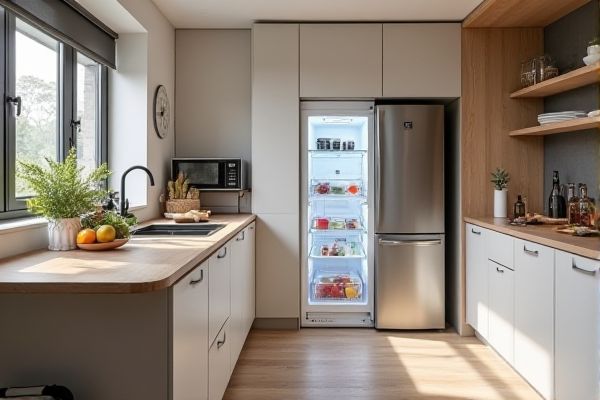
Choosing between a freestanding and built-in fridge impacts your kitchen's aesthetics, space utilization, and installation flexibility. Explore the key differences to determine which option best suits your needs and elevates your kitchen design.
Table of Comparison
| Feature | Freestanding Fridge | Built-in Fridge |
|---|---|---|
| Installation | Easy to install and relocate | Integrated into cabinetry, requires professional installation |
| Design | Visible outside, various styles and finishes | Seamlessly blends with kitchen decor |
| Size Options | Wide range of sizes and capacities | Limited sizes, designed to fit standard cabinet dimensions |
| Cost | Generally more affordable | Higher upfront and installation costs |
| Maintenance | Easy access for cleaning and repairs | More difficult due to integration with cabinets |
| Cooling Efficiency | Varies by model; often good airflow | Efficient cooling, designed for built-in use |
| Resale Value Impact | Less impact on home resale | Enhances kitchen aesthetics and home value |
Introduction to Freestanding and Built-In Fridges
Freestanding fridges offer versatile placement options and are easy to install, making them ideal for renters or those frequently rearranging their kitchen. Built-in fridges provide a seamless, integrated look by fitting flush with cabinetry, enhancing kitchen aesthetics while often requiring professional installation. Selecting between the two depends on kitchen design priorities, space availability, and budget considerations.
Key Differences Between Freestanding and Built-In Refrigerators
Freestanding refrigerators offer flexible placement options and typically come with higher storage capacity and easier installation compared to built-in models. Built-in refrigerators are designed to integrate seamlessly with cabinetry, providing a sleek, customized look while often having a shallower depth to align with counters. Pricing varies significantly, with built-in fridges generally costing more due to their design and integration features.
Design and Aesthetic Considerations
Freestanding fridges offer flexibility in placement and come in a wide range of styles and finishes, making them ideal for open-plan kitchens or areas where mobility is important. Built-in fridges integrate seamlessly into cabinetry, providing a sleek, uniform look that enhances modern kitchen designs and maximizes space efficiency. The choice between the two significantly impacts the overall kitchen aesthetic, with built-in models favored for minimalist, streamlined appearances and freestanding units suited for more eclectic or traditional decor.
Space and Installation Requirements
Freestanding fridges require minimal installation and can be easily moved, making them ideal for flexible kitchen layouts with ample space. Built-in fridges are designed to fit seamlessly into cabinetry, requiring precise measurements and professional installation to ensure a flush, integrated look. Your choice should consider kitchen size and whether you prioritize ease of installation or a streamlined aesthetic.
Flexibility and Placement Options
Freestanding fridges offer superior flexibility with easy mobility and placement anywhere in the kitchen or dining area, requiring only access to a power outlet. Built-in fridges are designed for seamless integration into cabinetry, providing a sleek, custom look but limiting relocation options once installed. Choosing between the two depends on whether adaptability or a streamlined aesthetic is a higher priority for your kitchen layout.
Storage Capacity and Interior Layout
Freestanding fridges typically offer flexible storage capacity with adjustable shelves and compartments that can be customized to fit your needs, making them suitable for larger households. Built-in fridges are designed to fit seamlessly into cabinetry, often resulting in slightly less interior space, but they provide efficient organization with specialized compartments for better food preservation. Your choice between the two depends on whether maximizing storage capacity or achieving a streamlined kitchen aesthetic is more important for your daily use.
Energy Efficiency and Performance
Freestanding fridges typically offer easier placement and flexibility but may have slightly lower energy efficiency compared to built-in models, which are designed to integrate seamlessly with cabinetry and often feature better insulation. Built-in fridges generally maintain more consistent internal temperatures, improving food preservation and overall performance by reducing energy waste. To optimize your kitchen's energy use, consider how each type aligns with your space layout and cooling needs.
Cost Comparison and Value
Freestanding fridges generally come with a lower upfront cost, making them an affordable option for most budgets, while built-in fridges demand a higher investment due to custom cabinetry and installation requirements. The value of a built-in fridge lies in its seamless integration and aesthetic enhancement of your kitchen, often increasing property appeal and long-term resale value. Your choice depends on balancing initial expenditure with design preference and potential home value appreciation.
Maintenance and Longevity
Freestanding fridges offer easier access for cleaning and maintenance due to their standalone design, allowing for thorough dust removal and vent clearing, which can extend appliance lifespan. Built-in fridges require careful installation with proper ventilation space to prevent overheating, and their integrated placement may complicate routine maintenance, potentially affecting longevity if not managed correctly. Regular filter checks and sealing of door gaskets are crucial for both types to maintain optimal performance and durability.
Choosing the Right Fridge for Your Home
When choosing the right fridge for your home, consider space availability and design preferences; freestanding fridges offer flexibility and easy installation with a variety of sizes, while built-in fridges provide seamless integration within cabinetry for a sleek, custom look. Energy efficiency ratings and storage capacity should also guide your decision to match household needs. Evaluate noise levels and accessibility features to ensure the fridge complements daily use and kitchen workflow.
 homyna.com
homyna.com